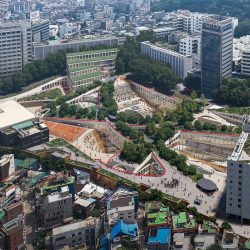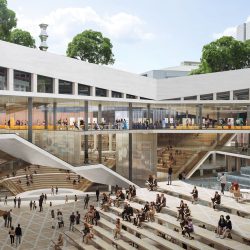
According to the Oxford Dictionary – or the Cambridge for that matter – a campus is “the buildings of a university or college and the land around them.” In the typical image that illustrates this definition the “land around them” is often a generous stretch of green land and the buildings a collection of politely distanced architectural objects. That is the case in Oxford. And Cambridge. And also for many campuses in Korea. The Hongik Seoul Campus, however, is different. Built in the 1950s on the slopes of the Wau Mountain in Seoul, it has been rapidly saturated with buildings, reaching the limits of expansion. “The land around them” hardly exists today. It has become “the land between them.”
That’s not to say there is no quality in Hongik. Its seemingly random arrangement of buildings and outdoor spaces has cultivated a culture of appropriating space, of generating new habitats for arts and science. Over time, this culture has expanded beyond the campus into the nearby Hongdae district, known today for its spontaneous performances, energy and nightlife. Today the relation between the campus and the city is under threat by its most recent additions that limit the physical connections between the two. But fortunately for the campus’s future, an open field at the foot of the mountain, quasi-unbuilt, has been made available for construction by a new planning ordinance from the Seoul Metropolitan Government – an opportunity to turn Hongik into a campus ‘by the book’, or simply continue its logic of densification?
Our design does both: It brings the missing green and maximizes the campus’ built up area. Conceived as a natural extension of the Wau Mountain, the new addition is situated below the ground. The buildings’ rooftops form a network of paths sheltered by trees, which connect the campus’ main access points with the adjacent neighborhood of Hongdae, an area known for its street art, local shops and nightlife. Between the buildings, courtyards bring light deep into the buildings and link the buildings in unexpected ways, forming a continuous sequence of outdoor spaces.
Programmatically, the new buildings are organized in three sectors: high-tech labs, close to the Engineering Faculty; amenities at the center; and maker spaces towards Hongdae. An art center will occupy the central buildings to serve as a bridge between education and culture, while the perimeter will host a ring-shaped multipurpose learning hub, which offers direct connectivity to surrounding faculty buildings. At the level of Hongdae, a central floor with public amenities runs through all buildings, inviting visitors inside, and allowing one to move up or down no more than three floors. It is the place where Hongik and Hongdae blend once again.
_





